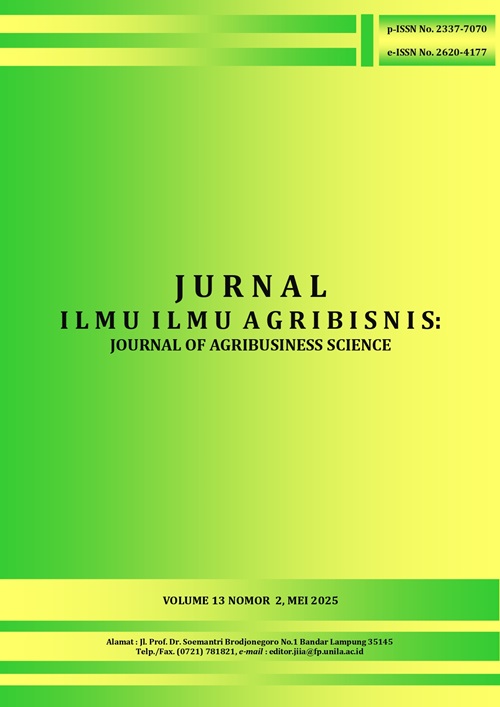EFISIENSI PEMASARAN RAJUNGAN DI KECAMATAN LABUHAN MARINGGAI KABUPATEN LAMPUNG TIMUR
DOI:
https://doi.org/10.23960/jiia.v13i2.10642 Abstract View: 103
Abstract View: 103
Abstract
This study aims to analyze the marketing efficiency of blue swimming crab in Labuhan Maringgai District, East Lampung Regency. The analytical method used was quantitative descriptive analysis to analyze marketing channels, marketing margins and marketing efficiency. This research was conducted in Muara Gading Mas Village and Margasari Village, Labuhan Maringgai District, East Lampung Regency. The number of respondents was 60 people including fishermen, breeders, miniplant owners in Labuhan Maringgai District, and UPI in Lampung Province. Data collection was carried out from November to December 2023. The results of the research show that the marketing channel for blue swimming crab in Labuhan Maringgai District has two marketing channels, namely marketing channel I (fishermen-miniplant-UPI), and marketing channel II (fisherman-middleman-miniplant-UPI). Marketing margin for blue swimming crabs in Labuhan Maringgai District, supervisory marketers have a marketing margin of IDR 19.941/kg. Miniplant marketing margin in marketing channel I is IDR 130.551/kg and Marketing Channel II is IDR 132.047/kg. UPI's marketing margin on marketing channels I and II is IDR 184,000/kg. The marketing efficiency of blue swimming crab in Labuhan Maringgai District in each marketing channel categorizes as inefficient because the value is more than 5% (Eps > 5%), except for middleman.
Keywords: blue swimming crab, efficiency, fisherman, marketing
Downloads
Downloads
Published
How to Cite
Issue
Section
License
Authors who publish with this journal agree to the following terms:
Authors retain copyright and grant the journal right of first publication with the work simultaneously licensed under a Creative Commons Attribution License that allows others to share the work with an acknowledgement of the work's authorship and initial publication in this journal.
Authors are able to enter into separate, additional contractual arrangements for the non-exclusive distribution of the journal's published version of the work (e.g., post it to an institutional repository or publish it in a book), with an acknowledgement of its initial publication in this journal.
Authors are permitted and encouraged to post their work online (e.g., in institutional repositories or on their website) prior to and during the submission process, as it can lead to productive exchanges, as well as earlier and greater citation of published work (See The Effect of Open Access).














